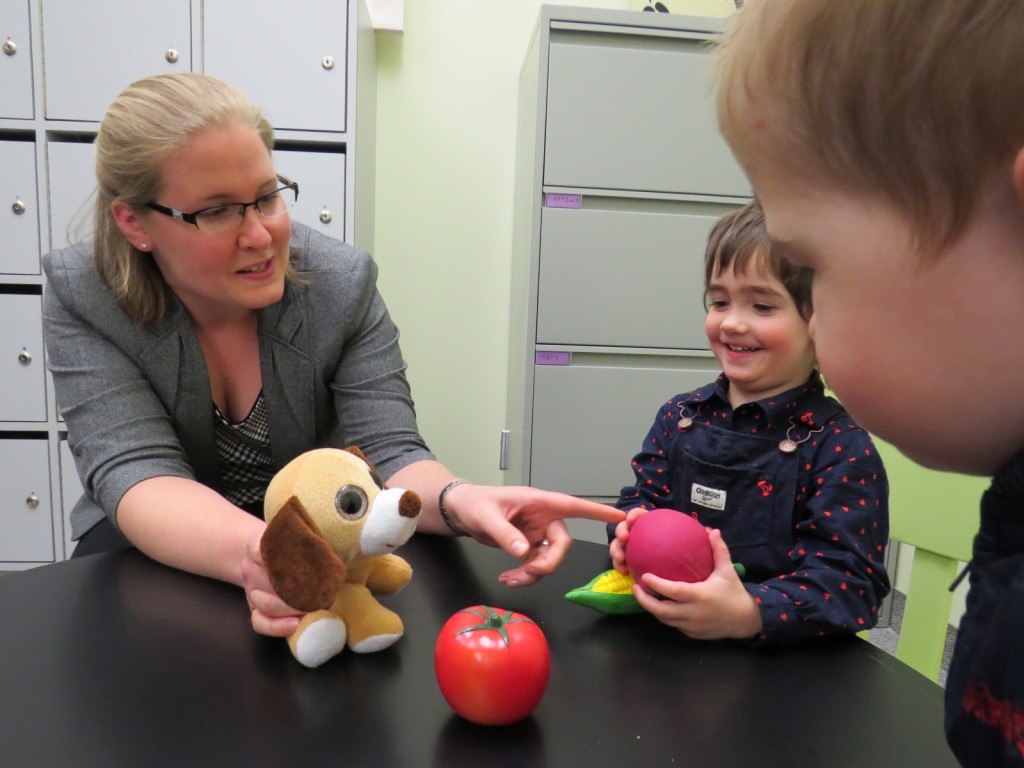
Developmental psychologist Caitlin Mahy is studying the differences between four and five-year-olds, and how they think and respond to different situations.
Most four-year-olds in Ontario will be starting a journey that hopefully will continue for many years to come: full-time school.
All-day junior kindergarten is still relatively new, a concept that Brock developmental psychologist Caitlin Mahy says has many benefits but also needs careful practice. Traditionally, children began their schooling with kindergarten at the age of five years.
At the core of Mahy’s research observations is that one year makes a monumental difference.
“There’s this huge transition between four-year-olds and five-year-olds in things like memory, social understanding, and self-regulation,” says Mahy. “Four-year-olds are going to struggle with a lot of skills that five-year-olds aren’t going to struggle with.”
And that is something teachers and parents, who might be tempted to view all kindergarteners as being similar, need to understand and adjust for, she says.
“We’re putting these children in kindergarten for a full day and we expect them to understand other peoples’ minds and remember to do things on their own,” explains Mahy. “Yet they’re really going to struggle with these abilities, especially compared to five-year-olds, who at least have some of those basic skills.”
The assistant professor in the Department of Psychology identifies three basic areas in which four-year-olds are different than their senior kindergarten peers.
One is “false belief” understanding, where a person is able to recognize that other people can have beliefs about the world that are different than his or her own.
Mahy refers to a laboratory test for children called the Sally Anne task. The researcher tells the child about a character who puts a marble in a basket and then goes away. Another character comes in, moves the marble from the basket to the box, and then leaves.
The researcher then asks the child the key question: When the first character comes back, where will that character look for the marble?
“What we found is that a lot of four-year-olds, when asked where will she look, will say, ‘In the box,’ because that’s where the marble is,” explains Mahy. “Four-year-olds have trouble understanding that the first character holds a false belief about where the marble is.
“By the age of five, most children know that the marble is in the box, but also that the first character will think that the marble is in the basket because she didn’t see the movement of the marble from the basket to the box take place.”
Mahy gives another example of a child who loves cookies and has a friend who loves broccoli. It will be hard for the four-year-old to understand that the friend loves something different than his or her own preference, cookies.
A second area of difference between four- and five-year-olds is in self-regulation, where a person is able to control his or her responses to stress, emotional expression, and other behaviours.
“In the classroom, this may look like, ‘sit in a circle, don’t yell out an answer, wait your turn,’ all these kinds of rules that involve children controlling their own impulses. That’s a big challenge for four-year-olds,” says Mahy. “Five-year-olds haven’t fully mastered that by any means, but they are so much better at it.”
Thirdly is the issue of “prospective memory,” or remembering to carry out what you had earlier planned to do, such as pick up a bag of milk on your way home from work.
This ability is often over-estimated in younger children, says Mahy. She refers to a friend whose four-year-old son was expected to hand in a notebook to his junior kindergarten teacher at the beginning of the day and collect the book from the teacher at the end of the day.
Not surprisingly, the teacher seldom received the book. “For teachers, it may be a lack of awareness of the limitations of four-year-olds because teachers are used to dealing with five-year-olds,” says Mahy. “I think there’s an assumption that four and five year olds are all kindergarteners, they’re all similar, but really, in their cognitive abilities, they’re different.”
And four-year-olds have a hard time following through on rules, despite the fact that they know the rules, says Mahy. They also may need more time to transition from recess to the classroom, as they are slower to inhibit behaviours, such as running or playing, that were appropriate on the schoolyard, she says.
Mahy urges teachers and parents to understand that four-year-olds are not going to be at the same level as five-year-olds and that there’s huge individual differences between children of the same age group.
She describes a number of strategies that help four-year-olds to practice certain skills. One is the game Simon Says, where children are instructed to pat their head, touch their toes or perform other tasks only when the leader says “Simon Says” or do nothing if the leader fails to say “Simon Says” before the command.
Another is to post prominent visual cues to remind children to do certain things, such as a big sign or a brightly coloured bottle in the bathroom to remind children to wash their hands. “Be patient, take time to explain things, explain what you wanted them to do versus what they did, model the behaviour you want to see,” says Mahy.
September 2015 marks the second year of full-day kindergarten, which Ontario’s Ministry of Education describes as being the “next step in our plan to help our kids get a better education in kindergarten through Grade 3,” says the ministry’s website.
“It helps kids get the best possible start. We’re helping make things better for students from their first day of school to their last – and every day in between.”
Then-education minister Kathleen Wynne (now Ontario’s premier) introduced a bill in 2009 establishing full-day kindergarten, with a five-year rollout plan.
Dr. Caitlin Mahy is looking for children ages 3 to 7 to participate in research studies on children’s development. Learn more about getting involved.
Read more about Dr. Mahy’s research.
To hear about the current research studies, contact: brockdmclab@gmail.com or 905-688-5550 x6089










We have always been teaching four year olds in our board (Dufferin-Peel) and prior to the Full Day Kindergarten (FDK), many of us were already teaching 4 and 5 year olds together in the half day program, in same classroom. Some boards had the two ages together for full days, alternate days. So we have realized, for a longtime, that there are differences between the two ages. Also, Ontario has had FDK for five years in some schools. Last year was the first year we ALL had FDK. For most four year olds, the full day program is a positive experience. However, parents must prepare there children beforehand. Also, if the young child seems to not be meeting basic milestones, don’t wait until school to address issues. Seek help. Many children are being sent to school unprepared or with developmental issues that have been ignored. That creates a lot of stress for the child and often the entire class.
I could go on and on,…
Full day kindergarten may be a huge deal to the school system but many children have attended full day Licenced Day Care for quite some time now. It’s a specialty area of education and care. Perhaps teachers should have received specialized education in order to be a Kindergarten or Junior Kindergarten teacher
ECE’s have specialized education in early development. This is why they have been brought in to partner with the classroom teacher in FDK.
It is not children that need to be prepared to enter kindergarten. It is the educators that need to be prepared to understand that every child is unique and competent and that they are all at different developmental stages. It is the educator that must make differential distinctions for each and every child.
Now we must work on the ratios. Maybe then we may have joyful, intrinsically motivated children who love to learn! Most Ontario Certified Teachers are ill prepared for early learning. Only RECEs are educated and ready for these children in this system. RECE’s must be the lead in these classrooms in order to see the true potential of early childhood education. Pay them what they are worth and see the magic!